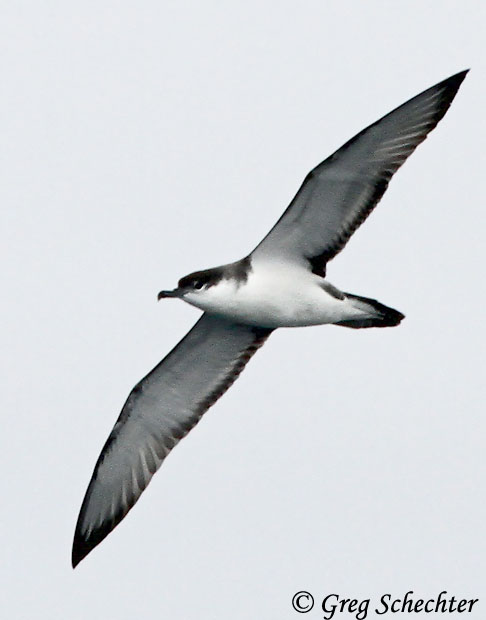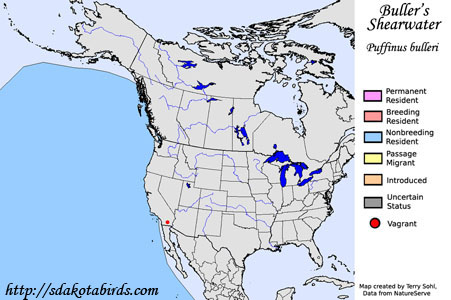| Length: 16 inches | Wingspan: 40 inches | Seasonality: Non-resident in South Dakota |
| ID Keys: White underside and flanks, gray upperparts and head cap, unique black and gray pattern on upper wings | ||
 The
Buller's Shearwater only breeds on a few areas in the Poor Knights Islands
of New Zealand, but are regular visitors during the summer and early fall
off the west coast of North America. They are relatively common off
the west coast of the U.S. in the late summer and early fall, and overall
populations appear to be stable. However, due to the extremely
restricted breeding range, there are conservation concerns about the
Buller's Shearwater, as a single disturbance event on their nesting islands
or the accidental introduction of predators such as rats could be
devastating to the species as a whole.
The
Buller's Shearwater only breeds on a few areas in the Poor Knights Islands
of New Zealand, but are regular visitors during the summer and early fall
off the west coast of North America. They are relatively common off
the west coast of the U.S. in the late summer and early fall, and overall
populations appear to be stable. However, due to the extremely
restricted breeding range, there are conservation concerns about the
Buller's Shearwater, as a single disturbance event on their nesting islands
or the accidental introduction of predators such as rats could be
devastating to the species as a whole.
Habitat: Nests on a few islands near New Zealand, with suitable soil for digging burrows, or with rocky areas with adequate protected sites for nest building. Outside of the breeding season, they are typically found near upwelling currents, far from shore.
Diet: Feeds mostly on fish, squid, and small crustaceans.
Behavior: May use a variety of foraging techniques to capture food at or near the surface of the ocean. This includes short plunge dives, swimming on the surface and plucking food items, or dipping down while in flight and skimming food items from near the surface.
Nesting: The nest of a Buller's Shearwater is in a burrow, in a crevice in a rocky area, or in another similar protected area. The nest itself consists of a lining of pebbles, twigs, and other vegetation. The female lays a single egg, and both the male and female help to incubate it. Upon hatching, both parents help to feed the young, regurgitating food that they have captured.
Song: Usually silent
Migration: Buller's Shearwaters only breed on the Poor Knights Islands in New Zealand. Outside of the breeding season, the move north in the Pacific, and can be common in parts of the Pacific in summer and early fall.
Interactive eBird Map: Click to access an interactive eBird map of Buller's Shearwater sightings
Similar Species: In range, most likely to be confused with the Pink-footed Shearwater. Other smaller shearwater species in the Pacific off North America have white underparts and darker upperparts, but the Buller's and the Pink-footed are the only two large shearwater species with such a pattern. If seen well, the "crisp" plumage of the Buller's, with sharper borders between light and dark, is obvious compared to the "muddier" Pink-footed Shearwater. Also similar to the Wedge-tailed Shearwater, a extremely rare vagrant in North America.
Conservation Status: Global populations of Buller's Shearwaters are still thought to number over 1 million birds. However, because of their extremely restricted breeding range, they are considered at risk from introduced predators or other disturbances on their breeding islands. The IUCN lists the Buller's Shearwater as a "Vulnerable" species.
Further Information: 1) BirdLife International - Buller's Shearwater
2) Audubon Guide - Buller's Shearwater
3) BirdWeb.org -Buller's Shearwater
Photo Information: Photo taken by Greg Schechter - September 24th, 2011 - Off the coast of Pacific Grove, California - Photo licensed under Creative Commons Attribution 2.0 Generic license.
| Click below for a higher-resolution map |
 |
| South Dakota Status: Non-resident in South Dakota |
Additional Buller's Shearwater Photos (coming soon!!)
